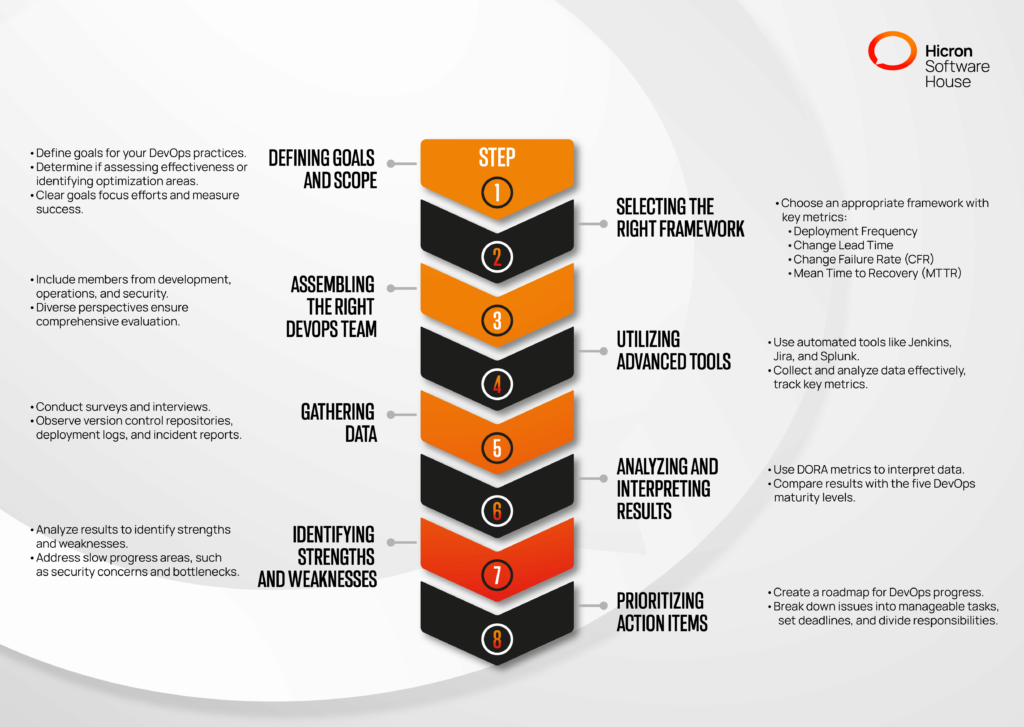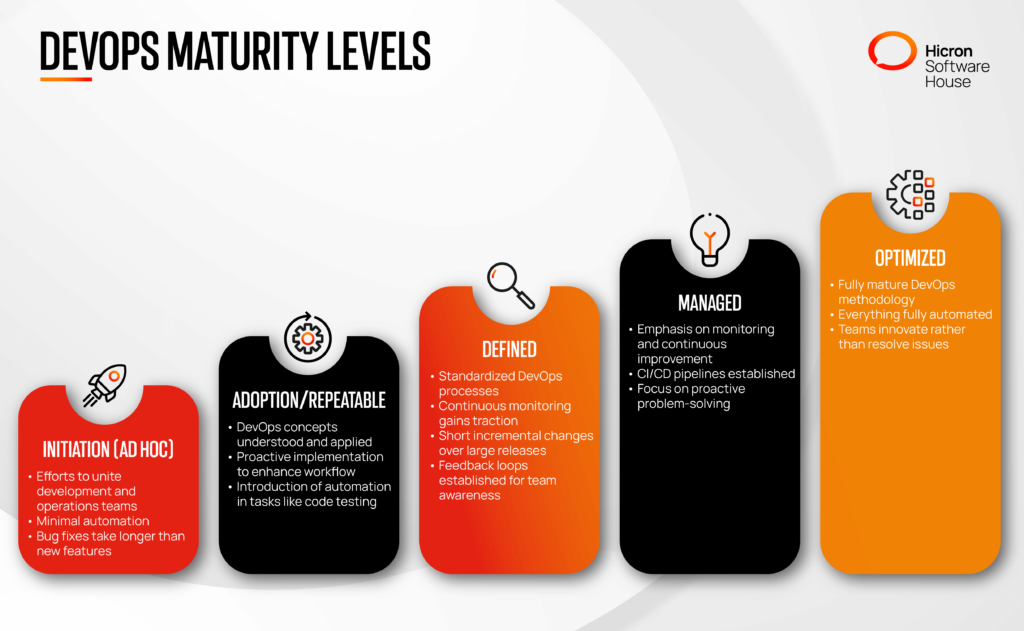How to Use DevOps for Digital Transformation
- April 21
- 4 min

More and more organizations are adopting DevOps practices as they seek to break away from the shackles of siloed development and operations teams. They want to enhance collaboration, accelerate delivery cycles, and improve software quality.
Despite the widespread adoption, many organizations still lack a clear understanding of the progress and effectiveness of their DevOps initiatives. This is where DevOps maturity models come in. Let’s discuss more about DevOps maturity, exploring the stages of maturity, and its benefits.
DevOps maturity is defined as a framework or practice that allows organizations to gauge how far the DevOps model has progressed. It also guides you about how much more effort you need to put in to achieve the desired results.
The DevOps maturity model evaluates various aspects of your organization, including silos in teams, speed of software delivery process, and use of automation tools.

This detailed evaluation helps your company in:
Let’s now discuss the key factors to determine your DevOps maturity.
The first thing that helps gauge your organization’s DevOps maturity level is its culture and strategy. For instance, mature DevOps teams are culture-driven and have proper policies and regulations in place for DevOps implementation.
They also have a robust organizational strategy, including a clear vision for continuous improvement and innovation. This strategy, backed by skilled leadership and proper resource allocation, is necessary for DevOps’ success.
The ultimate goal of DevOps is to swiftly provide high-quality software to the end users. Automation is critical in this regard, as it reduces manual efforts and increases deployment frequency.
Mature DevOps teams use automation tools like Jenkins and Jira in the build, test, and deployment stages. They use these tools to gain insight into system functioning and improve the reliability of the DevOps pipeline.
Mature DevOps teams are the ones who have dedicated processes for everything. For instance, they have an incident response plan to handle unexpected issues and communication channels to ensure seamless information flow across teams.
Another key characteristic of mature DevOps teams is excellent collaboration and task sharing. Everyone on the team, including QAs, developers, and operation managers, regularly discusses using different collaboration tools. They then work towards a common goal, breaking down silos between development, operations, and other stakeholders, taking business to the road to success.
There are plenty of benefits to a mature DevOps team. These DevOps teams are more confident about the quality of their software product and always prioritize customer satisfaction. Mature DevOps teams are also more comfortable with experimentation and innovating new products that help your business stay ahead of the competitors. Most importantly, they help organizations by offering a faster time to market and deploying fixes swiftly.
Typically, there are two types of assessment for DevOps maturity: self-assessment and external evaluation. In self-assessment, you evaluate your DevOps practices using standardized questionnaires and frameworks. While in external evaluation, you engage third-party experts to conduct a comprehensive review and provide objective insights into your DevOps maturity level.
Now that you’ve learned the key factors that show the maturity of a DevOps team, you must be wondering about how to conduct a DevOps maturity assessment practically. If so, the following tips are for you:
Start by defining the goals you wish to achieve with your DevOps practices. Is it finding the effectiveness of your current practices or identifying optimization areas? Having clear goals will make it easy for you to focus your efforts and measure success accurately.
It’s also important to select the right framework for assessment. This involves DORA metrics like:
These metrics provide a structured approach for measuring the impact of your DevOps practices and identifying areas for improvement.
Start by creating the right DevOps team to help you measure DevOps maturity. This team should include members from the development, operations, and security teams. Including diverse perspectives will pave the way for a detailed and comprehensive evaluation, ensuring that all aspects of the DevOps process are considered.
Once you’ve got all the professionals on board, you must leverage automated tools to collect and analyze data effectively. Tools like Jenkins, Jira, and Splunk can help track key metrics and provide insights into your DevOps processes.
Last but definitely not least, you need to gather data. For this, you can conduct surveys and interviews, asking specific questions from teams to understand their experiences and challenges. Additionally, observe your version control repositories, deployment logs, and incident reports to collect quantitative data on your DevOps processes.
Conducting a DevOps maturity assessment is essential to ensuring your DevOps practices are effective and continuously improving. This process helps you evaluate your current capabilities, identify areas for improvement, and create a roadmap to achieve higher goals.

1. Defining Goals and Scope
Start by defining the goals you wish to achieve with your DevOps practices. Determine if you want to assess the effectiveness of current practices or identify optimization areas. Clear goals will help you focus efforts and measure success accurately.
2. Selecting the Right Framework
Choose the appropriate framework for assessment, incorporating key metrics such as:
– Deployment Frequency: Calculate by dividing the number of deployments in a given period by the total number of days.
– Change Lead Time: Measure the time from when a developer starts writing code to when it’s provided to users.
– Change Failure Rate (CFR): Divide the number of failed deployments by the total number of deployments.
– Mean Time to Recovery (MTTR): Add the duration of each downtime and divide by the number of incidents.
3. Have the Right DevOps Team
Assemble a team that includes members from development, operations, and security. Diverse perspectives ensure a comprehensive evaluation of the DevOps process.
4. Make Use of Advanced Tools and Resources
Utilize automated tools like Jenkins, Jira, and Splunk to collect and analyze data effectively, track key metrics, and provide insights into your DevOps processes.
5. Gathering Data
Conduct surveys and interviews to understand team experiences and challenges. Observe version control repositories, deployment logs, and incident reports for quantitative data on DevOps processes.
6. Analyzing and Interpreting Results
Use the key DORA metrics to interpret data and determine your level of DevOps maturity. Understand the five DevOps maturity levels (Initiation, Adoption, Defined, Managed, Optimized) and compare them with your assessment results to see where you stand.
7. Identify Strengths and Weaknesses
Analyze the results to identify strengths and weaknesses. Address areas that show slow progress, such as security concerns, technical debts, or overall bottlenecks, and take steps to improve them.
8. Prioritize Action Items
Create a comprehensive roadmap for DevOps progress. Break down critical issues and weaknesses into small, manageable tasks, set strict deadlines, and divide responsibilities evenly to achieve high-level DevOps maturity.
Follow this detailed guide to perform a comprehensive DevOps maturity assessment and unlock the full potential of your DevOps initiatives.
The key DORA metrics have provided you with all the necessary data on your DevOps practices. Now, you should interpret it to determine which level of DevOps you stand. Here’s how you can do it:
Understand DevOps Maturity Levels
It’s important to understand the DevOps maturity levels and compare them with your DevOps assessment results to see where you stand.

The following are the 5 DevOps maturity levels:
Identify Strengths and Weaknesses
You should carefully analyze the DevOps maturity assessment results to identify your strengths and weaknesses. For instance, if the key performance indicators show slow progress, you should look at what’s not working.
It can be anything like security concerns, technical debts, or overall DevOps bottlenecks. Once you’ve figured out your weak areas, take steps toward improving them and change them into your strengths.
Prioritize Action Items
In this step, you should create a comprehensive roadmap for DevOps progress. For instance, you should prioritize action items based on the insights gained from your assessment.
Focus on addressing critical issues and weaknesses by breaking them into small, manageable tasks. Remember to set strict deadlines and divide responsibilities evenly to achieve high-level DevOps maturity.
Now, you should develop a detailed DevOps improvement plan to ensure your DevOps efforts yield the desired results. Here’s how you can do it:
To increase the impact of your DevOps initiatives, you must set Specific, Measurable, Achievable, Relevant, and Time-bound (SMART) business goals.
Net up, you should clearly define who is responsible for what task. Assign ownership to specific team members to create a culture of transparency and accountability. They should also be provided with the necessary tools and resources to complete the goals on time and efficiently.
A culture of continuous learning and improvement should exist to streamline all tasks. For this, DevOps teams should utilize automation tools and establish regular feedback loops so everyone knows critical issues and can take immediate steps to improve the DevOps lifecycle.
The DevOps maturity model helps your organization improve product quality and create a continuous integration and deployment culture. If implementing a DevOps maturity model seems like a hassle, you should trust the Hicron Software House.
Our expert DevOps team perfectly understands the five stages of DevOps maturity. We provide you with a faster and more agile resolution to software quality issues and minimize overall downtime. The cherry on the cake? We stay with you throughout the software development issues to ensure your products are top-notch and efficient. Get in touch with us today to pave the way for the DevOps maturity assessment and transformation journey.
